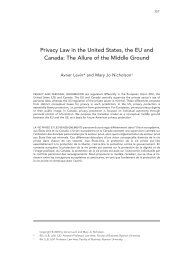Commentary on Fichte's “The Illegality of the Unauthorised ... - uoltj
Commentary on Fichte's “The Illegality of the Unauthorised ... - uoltj
Commentary on Fichte's “The Illegality of the Unauthorised ... - uoltj
You also want an ePaper? Increase the reach of your titles
YUMPU automatically turns print PDFs into web optimized ePapers that Google loves.
144 university <strong>of</strong> ottawa law & technology journal www.<strong>uoltj</strong>.ca<br />
opp<strong>on</strong>ent’s arguments, Fichte articulates what has come to be known as <strong>the</strong><br />
moral rights <strong>of</strong> <strong>the</strong> author. Moreover, in articulating <strong>the</strong>se rights, he goes fur<strong>the</strong>r<br />
than his c<strong>on</strong>temporaries in providing a <strong>the</strong>oretical justificati<strong>on</strong> for <strong>the</strong>se rights<br />
based <strong>on</strong> <strong>the</strong> nature <strong>of</strong> <strong>the</strong> author’s creative process. Fichte also argues that<br />
<strong>the</strong> recogniti<strong>on</strong> <strong>of</strong> property rights has implicati<strong>on</strong>s for fair competiti<strong>on</strong>—it would<br />
be unfair for <strong>the</strong> creator <strong>of</strong> a unique work to remain uncompensated for <strong>the</strong><br />
time invested in <strong>the</strong> creati<strong>on</strong>. 2 Fichte’s <strong>the</strong>ory <strong>of</strong> property is distinguished from<br />
that <strong>of</strong> his c<strong>on</strong>temporaries because it gives a prominent role to <strong>the</strong> relati<strong>on</strong>ships<br />
between people, ra<strong>the</strong>r than focusing solely <strong>on</strong> <strong>the</strong> individual. In my view, <strong>the</strong><br />
intersubjective approach that Fichte develops is quite different from <strong>the</strong> view<br />
<strong>of</strong> Immanuel Kant and o<strong>the</strong>r c<strong>on</strong>temporary rights-based legal <strong>the</strong>ories. These<br />
<strong>the</strong>orists <strong>on</strong>ly take into account intersubjectivity in two regards: first, <strong>the</strong>y c<strong>on</strong>sider<br />
that an individual’s rights are limited by <strong>the</strong> equal rights <strong>of</strong> ano<strong>the</strong>r; sec<strong>on</strong>d,<br />
<strong>the</strong>y c<strong>on</strong>sider that corrective justice requires that <strong>the</strong> defendant is <strong>on</strong>ly liable for<br />
<strong>the</strong> damage suffered by <strong>the</strong> plaintiff— i.e., damages serve <strong>the</strong> primary functi<strong>on</strong><br />
<strong>of</strong> correcting <strong>the</strong> wr<strong>on</strong>g suffered by <strong>the</strong> plaintiff. 3 Law deals with <strong>the</strong> fact that<br />
two isolated individuals have come into c<strong>on</strong>tact, and its purpose is to regulate<br />
<strong>the</strong> results <strong>of</strong> this c<strong>on</strong>tact. In c<strong>on</strong>trast, Fichte sees intersubjectivity as playing a<br />
more substantive role in c<strong>on</strong>stituting rights. For him, we can <strong>on</strong>ly c<strong>on</strong>ceive <strong>of</strong><br />
<strong>the</strong> individual in <strong>the</strong> c<strong>on</strong>text <strong>of</strong> a relati<strong>on</strong> with o<strong>the</strong>rs, 4 which leads Fichte to <strong>the</strong><br />
c<strong>on</strong>clusi<strong>on</strong> that we are bound to o<strong>the</strong>rs “by our very existence.” 5 Law does not<br />
simply arise from <strong>the</strong> necessary encounter <strong>of</strong> isolated individuals, but from <strong>the</strong><br />
fact that human existence is necessarily intersubjective existence. 6<br />
Finally, Fichte’s essay <strong>on</strong> copyright tries to answer some <strong>of</strong> <strong>the</strong> questi<strong>on</strong>s<br />
that have c<strong>on</strong>stantly plagued rights-based views <strong>of</strong> intellectual property: What is<br />
<strong>the</strong> unique intellectual aspect <strong>of</strong> a creative work? How does this unique aspect<br />
relate to <strong>the</strong> individuality <strong>of</strong> its creator? and How does this originality give rise to<br />
a property interest? The answers to <strong>the</strong>se questi<strong>on</strong>s raise difficult issues about<br />
<strong>the</strong> functi<strong>on</strong>ing <strong>of</strong> our intellect. Fichte’s unique epistemology provides an original<br />
answer about <strong>the</strong> nature <strong>of</strong> this functi<strong>on</strong>ing and, as a result, it provides an original<br />
answer to <strong>the</strong>se questi<strong>on</strong>s. Unlike his c<strong>on</strong>temporary, Kant, Fichte c<strong>on</strong>siders <strong>the</strong><br />
creati<strong>on</strong> <strong>of</strong> knowledge to involve both <strong>the</strong> external object and <strong>the</strong> imprint <strong>of</strong><br />
<strong>the</strong> free individual who perceives it. While Kant denied <strong>the</strong> possibility <strong>of</strong> true<br />
objectivity because <strong>of</strong> our inability to know things as <strong>the</strong>y are independent <strong>of</strong> our<br />
percepti<strong>on</strong>s <strong>of</strong> <strong>the</strong>m, Fichte c<strong>on</strong>sidered objects as real limits <strong>on</strong> <strong>the</strong> power <strong>of</strong> our<br />
2. Johann Gottlieb Fichte, “Beweis der Unrechtmäßigkeit des Büchernachdrucks: Ein Räs<strong>on</strong>nement und eine<br />
Parabel (1793), (2008) 5:1&2 University <strong>of</strong> Ottawa Law & Technology Journal 141 at pp. 171-197;<br />
Johann Gottlieb Fichte, “Pro<strong>of</strong> <strong>of</strong> <strong>the</strong> <strong>Illegality</strong> <strong>of</strong> <strong>the</strong> <strong>Unauthorised</strong> Reprinting <strong>of</strong> Books: An Argument<br />
and a Parable,” trans. Graham Mayeda, (2008) 5:1&2 University <strong>of</strong> Ottawa Law & Technology Journal 141 at<br />
pp. 171-197 at para. 22.<br />
3. See Ernest J Weinrib, The Idea <strong>of</strong> Private Law (Harvard University Press, 1995); and Arthur Ripstein, Equality,<br />
Resp<strong>on</strong>sibility and <strong>the</strong> Law (Cambridge University Press, 1999), for examples <strong>of</strong> c<strong>on</strong>temporary rights-based<br />
legal <strong>the</strong>ories.<br />
4. Fichte, Foundati<strong>on</strong>s <strong>of</strong> Natural Right, supra note 1 at p. 45:<br />
[T]he c<strong>on</strong>cept <strong>of</strong> individuality is a reciprocal c<strong>on</strong>cept, i.e. a c<strong>on</strong>cept that can be thought <strong>on</strong>ly in<br />
relati<strong>on</strong> to ano<strong>the</strong>r thought, and <strong>on</strong>e that (with respect to its form) is c<strong>on</strong>diti<strong>on</strong>ed by ano<strong>the</strong>r—<br />
indeed by an identical—thought. This c<strong>on</strong>cept can exist in a rati<strong>on</strong>al being <strong>on</strong>ly if it is posited as<br />
completed by ano<strong>the</strong>r rati<strong>on</strong>al being. Thus this c<strong>on</strong>cept is never mine; ra<strong>the</strong>r, it is—in accordance<br />
with my own admissi<strong>on</strong> and <strong>the</strong> admissi<strong>on</strong> <strong>of</strong> <strong>the</strong> o<strong>the</strong>r—mine and his, his and mine; it is a shared<br />
c<strong>on</strong>cept within which two c<strong>on</strong>sciousnesses are unified into <strong>on</strong>e.<br />
5. Fichte, Foundati<strong>on</strong>s <strong>of</strong> Natural Right, supra note 1 at p. 45.<br />
6. Fichte, Foundati<strong>on</strong>s <strong>of</strong> Natural Right, supra note 1 at pp. 37–38.









